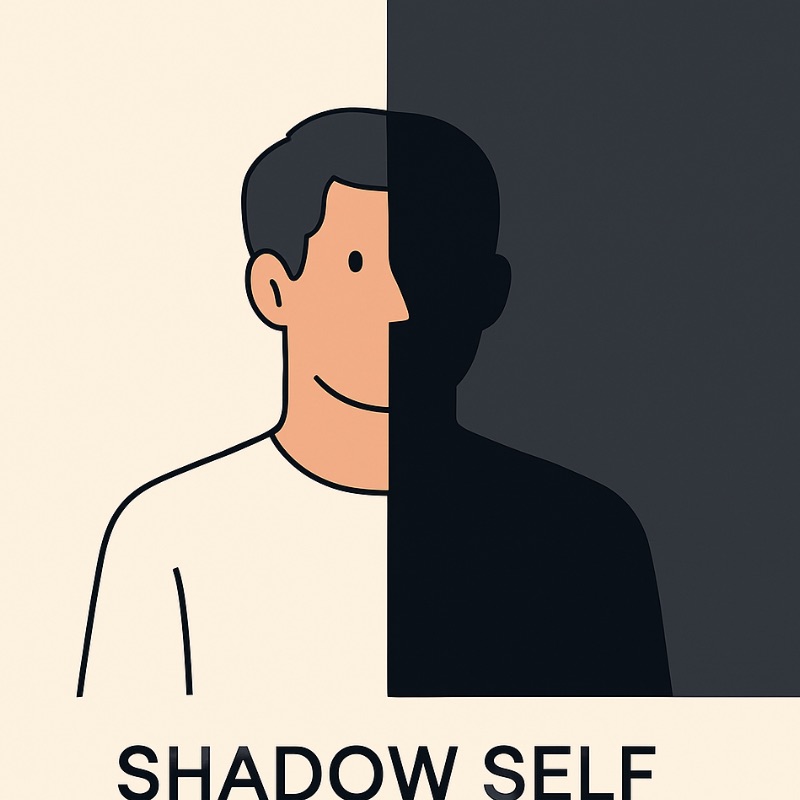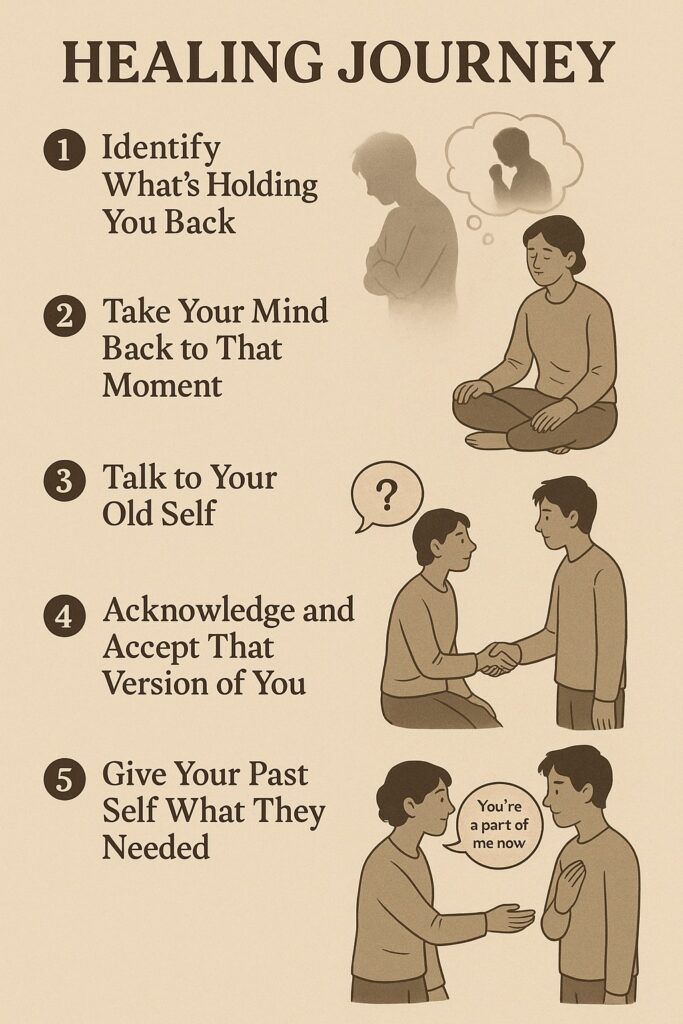
Shadow work is a powerful self growth practice that helps you explore the hidden parts of your personality often the parts you try to avoid or suppress. Popularised by psychologist Carl Jung, shadow work helps uncover your unconscious patterns, limiting beliefs, and emotional triggers. In this guide, you’ll learn what shadow work is, how to start, and why it’s essential for emotional healing and spiritual growth.
Table of Contents
What Is Shadow Work?
Shadow work is the practice of exploring your unconscious mind the “shadow self.”
Imagine a person who looks completely fine on the outside healthy, energetic, always smiling. Let’s call this the “white” side. But deep inside, there are thoughts, feelings, and memories that only he knows. He hides them from the world and keeps them locked away, like when you’re alone in a room with your real self your true thoughts, fears, and emotions.

This hidden side is called the shadow self. It’s not evil or wrong,it’s just the part of you that you don’t show others. But it’s still you.
When you keep living with these two sides the bright, polished outside (white) and the hidden, unspoken inside (black) without accepting or understanding the shadow, it creates inner conflict. This often shows up as stress, anxiety, or even depression.
By doing shadow work, you bring these aspects to light, understand them, and integrate them in a healthy way.The day you start turning the black part into white.when you reduce the gap between the two sides, face what’s hidden, and you learn how to deal with it and heal it , it changes your life completely.
How to Begin Shadow Work:5 Simple Steps
1) Identify What’s Holding You Back
Start by recognizing what’s pulling you down or keeping you stuck. It could be something from your childhood, a past relationship, your work environment, your friend circle, or anything that still affects your thoughts, emotions, or behaviour today. These unresolved experiences often shape how we feel and respond, even if we don’t realize it
2) Take Your Mind Back to That Moment
Close your eyes and gently guide yourself back to that memory,the moment connected to your shadow, the part of you that still feels heavy, painful, or unresolved.
Allow yourself to be present in that memory, not to relive the pain, but to understand it. You can do this in a quiet, private space where you feel safe maybe in your room, a peaceful park, or anywhere you won’t be disturbed.
This step is about facing what you’ve been avoiding, with compassion and courage.
3) Talk to Your Old Self
Once you’re in that memory, gently begin a conversation with your past self.
Ask:
“Why were you feeling this way?”
“What made you act like that?”
“Was there anything that felt right at that time?”
Speak to that version of you not with judgment, but with curiosity and compassion. Try to understand what that “you” needed back then. What were they afraid of?
This dialogue helps you connect the dots between your past and present feelings, and it’s a powerful step toward healing.
4) Acknowledge and Accept That Version of You
Don’t try to fix or fight your old self just acknowledge them. Say to yourself:
“I see you. I understand why you felt that way.”
“You did what you could with what you knew back then.”
This is not about blaming or regretting. It’s about accepting that version of you with love. The more you accept your past self, the more you free your present self.
Healing begins when you stop running from your shadow and start embracing it as a part of your journey.
5) Give Your Past Self What They Needed
Now, imagine giving your past self the things they never received support, understanding, kindness, or just a safe space to feel. Tell them what they needed to hear back then:
“You’re not alone.”
“It’s okay to feel this.”
“You did your best.”
Offer your past self a new way of seeing things help them shift their perspective. Maybe they blamed themselves when it wasn’t their fault. Maybe they felt powerless when they actually showed strength.
Encourage that version of you to grow, not by force, but with love. Then, bring them into your present.
Say:“You’re a part of me now. But I’m wiser, stronger, and I’ve learned. Let’s move forward together.”
This is how healing happens not by erasing the past, but by integrating it into your story with compassion and clarity.

Also read:How to Find Motivation When Depressed: 6 Real Strategies That Work
Common Challenges in Shadow Work (and How to Overcome Them)
1. Emotional Overwhelm
Challenge: Old wounds may trigger intense emotions like anger, sadness ,irritability of not able to do something when it was on your hand .
Solution: Go slow ,don’t become hyperactive.Take breaks ,calm yourself down .Use techniques like deep breathing,walk in your backyard or an open field .Try to control your mind.
2. Resistance or Denial
Challenge: You may feel like avoiding painful memories or convincing yourself “it’s not a big deal.”
Solution: Gently remind yourself that healing doesn’t mean reliving pain,it means understanding it with full consciousness by opening the doors of all consciousnesses which include mind ,body ,soul, your physical self.
3. Self-Judgment
Challenge: You might criticize your past self or feel ashamed for how you reacted or felt because ,now you can not rewind the time and what’s gone is gone,times waits for none.
Solution: Replace judgment with curiosity. Ask, “Why did I feel that way?” instead of “What’s wrong with me?” Try to fix the root cause of why i feel and what’s wrong and figure out the most possible solution to your past doings which you could have done in other positive possible way.
4. Feeling Lost or Confused
Challenge: You might not know where to start or what you’re even looking for.you might feel a bit confuse and lost for sometime.
Solution: Use simple prompts or structured steps (like the 5-step guide above). Trust the process it unfolds over time,nothing in this world can be made overnight,everything need time to show it’s peak result.
5. Wanting Quick Results
Challenge: Shadow work isn’t a one-time fix. Impatience can lead to frustration,anxiety,depression and sometime you may feel like nothing is working .
Solution: Treat it like emotional fitness. Progress is slow but powerful. Celebrate small insights and shifts ,give some time trust the process,have patience,good things takes time.
Benefits of Shadow Work
• Increases self-awareness
• Helps you heal from past trauma
• Reduces emotional triggers
• Improves emotional intelligence
• Builds inner strength and resilience
• Increases self-acceptance
• Helps break negative patterns
• Enhances personal growth
• Unlocks hidden potential and energy.
Frequently Asked Questions (FAQs)
Q1: Is shadow work dangerous?
A: Shadow work is not dangerous, but it can be emotionally intense. It’s best done in a safe space, and with professional support if needed.
Q2: How often should I do shadow work?
A: Start with once or twice a week. It’s more important to be consistent than frequent. Go at your own pace.
Q3: Can I do shadow work without a therapist?
A: Yes, many people do it on their own through journaling, meditation, and self-reflection. However, a therapist can help guide you through deeper layers.
Q4: What are some signs I need shadow work?
A: If you often feel triggered, stuck, emotionally reactive, or disconnected from your true self it might be time to explore shadow work.
Q5: Is shadow work part of spirituality or psychology?
A: Both. Shadow work has roots in Jungian psychology but is also used in spiritual and self-growth practices.
Hi, I’m Swaraj Das a registered pharmacist by profession and a passionate blogger at heart. I love writing about wellness, spirituality, uplifting lifestyle tips, practical life lessons, and inspiring stories. Through my words, I aim to bring clarity, motivation, and well being to everyday life.


